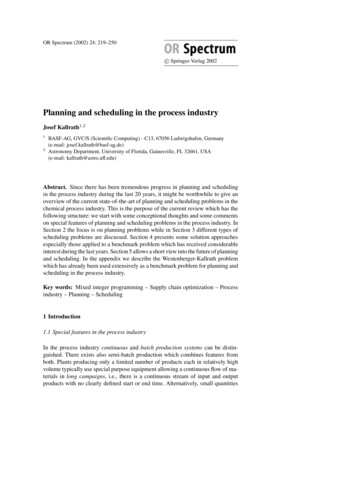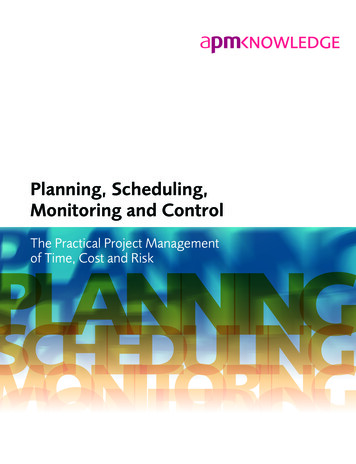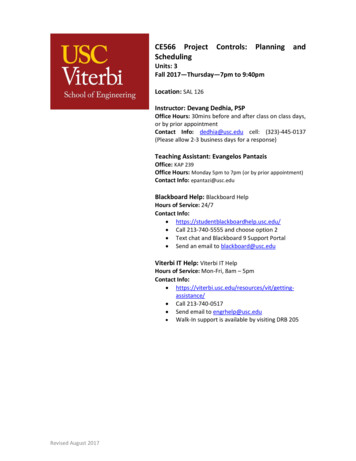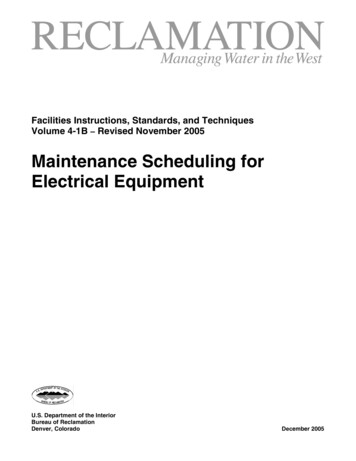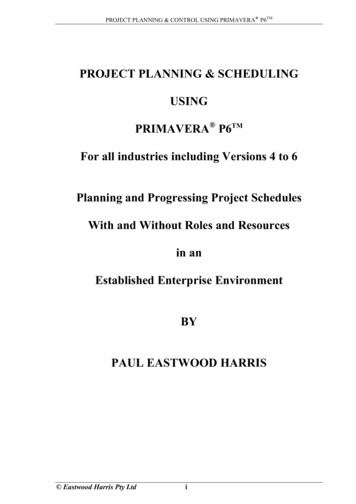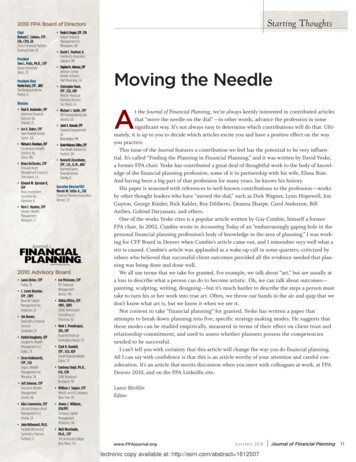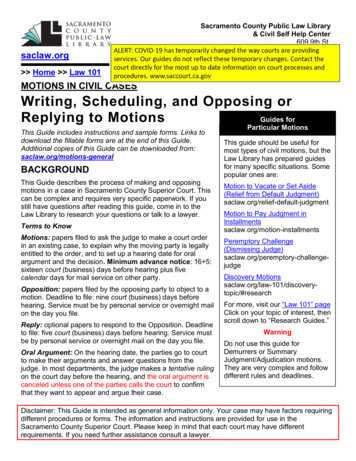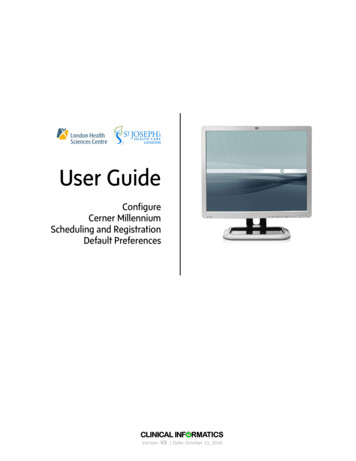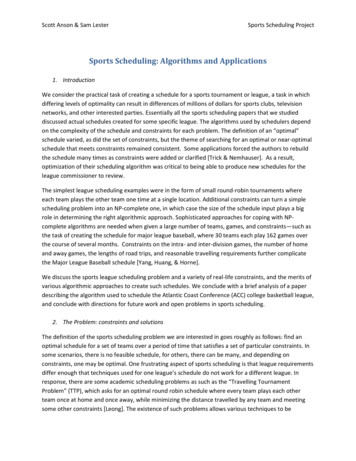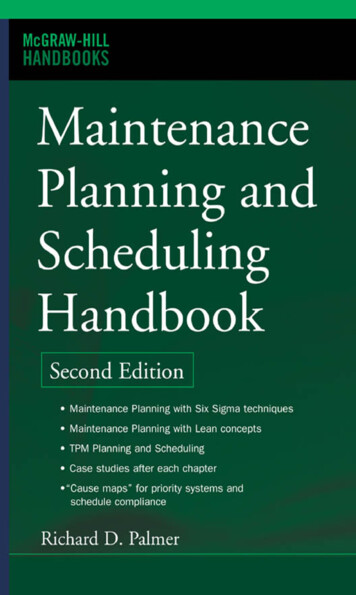
Transcription
MaintenancePlanning andSchedulingHandbook
This page intentionally left blank
MaintenancePlanning andSchedulingHandbookDoc PalmerSecond EditionMcGraw-HillNew YorkChicago San Francisco Lisbon London MadridMexico City Milan New Delhi San Juan SeoulSingapore Sydney Toronto
Copyright 2006 by Richard D. Palmer. All rights reserved. Manufactured in the United States ofAmerica. Except as permitted under the United States Copyright Act of 1976, no part of this publication may be reproduced or distributed in any form or by any means, or stored in a database or retrievalsystem, without the prior written permission of the publisher.0-07-150155-XThe material in this eBook also appears in the print version of this title: 0-07-145766-6.All trademarks are trademarks of their respective owners. Rather than put a trademark symbol afterevery occurrence of a trademarked name, we use names in an editorial fashion only, and to the benefit of the trademark owner, with no intention of infringement of the trademark. Where such designations appear in this book, they have been printed with initial caps.McGraw-Hill eBooks are available at special quantity discounts to use as premiums and sales promotions, or for use incorporate training programs. For more information, please contact George Hoare,Special Sales, at george hoare@mcgraw-hill.com or (212) 904-4069.TERMS OF USEThis is a copyrighted work and The McGraw-Hill Companies, Inc. (“McGraw-Hill”) and its licensorsreserve all rights in and to the work. Use of this work is subject to these terms. Except as permittedunder the Copyright Act of 1976 and the right to store and retrieve one copy of the work, you may notdecompile, disassemble, reverse engineer, reproduce, modify, create derivative works based upon,transmit, distribute, disseminate, sell, publish or sublicense the work or any part of it withoutMcGraw-Hill’s prior consent. You may use the work for your own noncommercial and personal use;any other use of the work is strictly prohibited. Your right to use the work may be terminated if youfail to comply with these terms.THE WORK IS PROVIDED “AS IS.” McGRAW-HILL AND ITS LICENSORS MAKE NO GUARANTEES OR WARRANTIES AS TO THE ACCURACY, ADEQUACY OR COMPLETENESS OFOR RESULTS TO BE OBTAINED FROM USING THE WORK, INCLUDING ANY INFORMATION THAT CAN BE ACCESSED THROUGH THE WORK VIA HYPERLINK OROTHERWISE, AND EXPRESSLY DISCLAIM ANY WARRANTY, EXPRESS OR IMPLIED,INCLUDING BUT NOT LIMITED TO IMPLIED WARRANTIES OF MERCHANTABILITY ORFITNESS FOR A PARTICULAR PURPOSE. McGraw-Hill and its licensors do not warrant orguarantee that the functions contained in the work will meet your requirements or that its operationwill be uninterrupted or error free. Neither McGraw-Hill nor its licensors shall be liable to you or anyone else for any inaccuracy, error or omission, regardless of cause, in the work or for any damagesresulting therefrom. McGraw-Hill has no responsibility for the content of any information accessedthrough the work. Under no circumstances shall McGraw-Hill and/or its licensors be liable for anyindirect, incidental, special, punitive, consequential or similar damages that result from the use of orinability to use the work, even if any of them has been advised of the possibility of such damages. Thislimitation of liability shall apply to any claim or cause whatsoever whether such claim or causearises in contract, tort or otherwise.DOI: 10.1036/0071457666
ProfessionalWant to learn more?We hope you enjoy thisMcGraw-Hill eBook! Ifyou’d like more information about this book,its author, or related books and websites,please click here.
To Jesus and Nancy
This page intentionally left blank
For more information about this title, click hereContentsForewordxixPrefacexxiPreface to First EditionxxiiiAcknowledgmentsxxixPrologue: A Day in the Life—May 10, 2010xxxiChapter 1. The Benefit of PlanningCompany VisionWhy Improvement Is Needed in MaintenanceWhat Planning Mainly Is and What It Is Mainly Not(e.g., Parts and Tools)How Much Will Planning Help?The practical result of planning: freed-up technicians“World class” wrench timeThe specific benefit of planning calculatedWhy does this opportunity exist?Quality and Productivity Effectiveness and EfficiencyPlanning MissionFrustration with PlanningSummaryOverview of the Chapters and AppendicesChapter 2. Planning PrinciplesThe Planning Vision; The MissionPrinciple 1: Separate DepartmentIllustrationsPrinciple 2: Focus on Future WorkIllustrationsPrinciple 3: Component Level FilesIllustrationsCaution on computerizationPrinciple 4: Estimates Based on Planner ExpertiseIllustrationsPrinciple 5: Recognize the Skill of the 33940444647535563vii
viiiContentsPrinciple 6: Measure Performance with Work SamplingIllustrationsSummaryChapter 3. Scheduling PrinciplesWhy Maintenance Does Not Assign Enough WorkAdvance Scheduling Is an AllocationPrinciple 1: Plan for Lowest Required Skill LevelIllustrationsPrinciple 2: Schedules and Job Priorities Are ImportantIllustrationsPrinciple 3: Schedule from Forecast of Highest Skills AvailableIllustrationsPrinciple 4: Schedule for Every Work Hour AvailableIllustrationsPrinciple 5: Crew Leader Handles Current Day’s WorkIllustrationsPrinciple 6: Measure Performance with Schedule ComplianceIllustrationsSummaryChapter 4. What Makes the Difference and Pulls It All TogetherProactive versus Reactive MaintenanceExtensive versus Minimum MaintenanceCommunication and Management SupportOne Plant’s Performance (Example of Actual Success)Desired Level of EffectivenessSummaryChapter 5. Basic PlanningA Day in the Life of a Maintenance PlannerWork Order SystemPlanning ProcessWork Order FormCoding Work OrdersUsing and Making a Component Level FileScoping a JobTroubleshootingPerformance testing or engineeringIllustrationsEngineering Assistance or ReassignmentDeveloping Planned Level of Detail,Sketching and DrawingAttachmentsEnglish 101Craft Skill LevelEstimating Work Hours and Job 39141142143144147148149153157
ContentsEquipment parts listPurchasingStoreroom, reserving, and stagingSpecial ToolsJob SafetyConfined spaceMaterial safety data sheetsEstimating Job CostContracting Out WorkInsulationOther contracted out workClosing and Filing Feedback after Job ExecutionSummaryChapter 6. Advance 9183Weekly SchedulingForecasting work hoursSorting work ordersAllocating work ordersFormal Weekly Schedule MeetingStaging Parts and ToolsWhat to stageWhere to stageWho should stageThe process of stagingOutage SchedulingPlanning work orders for outagesKey concepts in scheduling for outagesQuotas, Benchmarks, and Standards 29229235238Chapter 7. Daily Scheduling and Supervision241A Day in the Life of a Maintenance SupervisorAssigning NamesCoordinating with the Operations GroupHanding Out Work OrdersDuring Each DaySummary241246254256259260Chapter 8. Forms and Resources Overview261FormsResourcesComponent level files—minifilesEquipment History Files (Including system files and minifiles)Technical FilesAttachment filesVendor FilesEquipment parts listsStandard plans262266266269272273274274274
xContentsLube oil manualMSDSPlant schematicsRotating or critical spares programSecurity of FilesSummaryChapter 9. The Computer in MaintenanceA Day in the Life of a Maintenance Planner(Using a CMMS)What Type of ComputerizationSoftware already in useSingle user or larger networkCreating versus purchasing a commercial CMMSBenefits with the CMMSStandardizing work processesInventory controlInformation for metrics and reportsFinding work ordersLinking information to equipmentCommon databaseSchedulingPM generationProblem diagnosis and root causeanalysis supportCautions with the CMMSFaulty processesReliability and speedBackup systemCost assignmentEmployee evaluationsGoldfish bowlUnnecessary metricsEliminate paper?Jack of all trades, master of noneArtificial intelligenceTemplatesUser friendlyCost and logisticsSelection of a CMMSTeamProcessSpecific Planning Advice to Go Along with a CMMSAdvanced Helpful Features for Planning and SchedulingSummaryChapter 10. Consideration of Preventive Maintenance, PredictiveMaintenance, and Project WorkPreventive Maintenance and PlanningPredictive Maintenance and PlanningProject Work and 1302303303304304305305306308310311313313319320
ContentsChapter 11. ControlOrganization Theory 101: The Restaurant StorySelection and Training of PlannersIndicatorsPlanned coverageProactive versus reactiveReactive work hoursWork typeSchedule forecastSchedule complianceWrench timeMinifiles madeBacklog work ordersWork orders completedBacklog work 336337338338Chapter 12. Conclusion: Start Planning341Epilogue: An Alternative Day in the Life—May 10, 2010345Bill, Mechanic at Delta Ray, Inc.Sue, Supervisor at Zebra, Inc.Juan, Welder at Alpha X, Inc.Jack, Planner at Johnson Industries, Inc.Appendix A. Planning Is Just One Tool; What Are the OtherTools Needed?Work Order SystemEquipment Data and HistoryLeadership, Management, Communication, Teamwork(Incentive Programs)Qualified PersonnelClassificationHiringTrainingShops, Tool Rooms, and ToolsStoreroom and Rotating SparesReliability MaintenancePreventive maintenancePredictive maintenanceProject maintenanceImproved Work ProcessesMaintenance MetricsSummaryAppendix B. The People Side of PlanningThe People Rules of PlanningRule 1: The planning program is not trying to give away the plant'swork to 382386387390393396397403405406406
xiiContentsRule 2: Planners cannot plan the perfect jobRule 3: Planning is not designed to take the brains out ofthe techniciansRule 4: The technicians own the job after the supervisorassigns it to themRule 5: Planners cannot make the perfect time estimateRule 6: Management cannot hold technicians accountable to timeestimates for single jobsRule 7: Showing what is not correct is often as important asshowing what is correctRule 8: Planners do not add value if they help jobs-in-progressRule 9: Everyone is an adultRule 10: Everyone should enjoy their workRule 11: Everyone should go home at the end of each day knowing ifthey have won or lostRule 12: Wrench time is not strictly under the controlof the techniciansRule 13: Schedule compliance is not strictly under the controlof the crew supervisorsRule 14: It is better to train employees and lose them than to nottrain them and keep themRule 15: Modern maintenance needs to do less with lessSummaryAppendix C. What to Buy and WhereMinifile FoldersMinifile LabelsMiscellaneous Office SuppliesEquipment TagsWire to Hang Tags on EquipmentDeficiency TagsShop Ticket HoldersOpen Shelf 6417419419420420421422423423423424Appendix D. Sample Forms and Work Orders425Appendix E. Step-by-Step Overview of Planner Duties453Appendix F. Step-by-Step Overviews of Others’ Duties459Maintenance SchedulerMaintenance Planning ClerkNew work ordersAfter job executionOther dutiesOperations CoordinatorMaintenance Purchaser or ExpediterCrew SupervisorBefore job executionDuring job execution459460460460460461461462462462
ContentsAfter job executionOther dutiesPlanning SupervisorMaintenance ManagerMaintenance Planning Project ManagerMaintenance AnalystAppendix G. Sample Work Sampling (Wrench Time) Study: “Ministudy”Work Sampling Study of I&C Maintenance, October–December 1993.Final Report, March 25, 1994.Table of ContentsExecutive SummaryIntroductionCategory DefinitionsWorkingWaitingOtherUnaccountableStudy ResultsCollection of observation dataAnalysisConclusionsRecommendationsAttachment A: Procedure for Measuring Work Force Productivity byWork SamplingAttachment B: Work Sampling CalculationsAppendix H. Sample Work Sampling (Wrench Time) Study:Full-Blown StudyWork Sampling Study of Mechanical Maintenance, January–March 1993.Final Report, April 29, 1993Table of ContentsExecutive SummaryIntroductionCategory DefinitionsStudy ResultsCollection of Observation nt A: Procedure for measuring workforce productivity bywork samplingAttachment B: Work sampling calculationsAppendix I. Special Factors Affecting ProductivityWrench Time in Exceptional Crafts and PlantsBlanket Work OrdersEmpowering versus SchedulingDefinitions and 4494495517553554555557561561562563564
xivContentsEmpowered to do what?Proper empowered responsibility between planning and crew supervisionThe result of proper empowermentSchedule ComplianceMajor causesOverloaded scheduleCrew not making itSchedule breakersLow producing crewsPriority SystemsMajor causesChoiceNo priority system in realityGaming the priority systemSummaryAppendix J. Work Order System and CodesCompany Work Order System ManualTable of ContentsIntroductionWork FlowWork Order Form and Required FieldsCMMS Instructions for Plant-Wide UseCodesPriorityStatusDepartment and crewWork typeHow foundPlan typeOutagePlant and unitEquipment group and systemEquipment typeProblem class, problem mode, problem cause, action takenWork Order Numbering SystemCurrent numbering systemPrevious numbering systemsNotesManual DistributionAppendix K. Equipment Schematics and TaggingEquipment Tag NumbersEquipment Tag Creation and PlacementSummaryAppendix L. Computerized Maintenance Management SystemsPlanning Principles versus Using a CMMSHelpful Features for Planning and SchedulingUser friendlySpeed is 2654
ContentsReliability is secondInventory helpIs this a modification? Rework? Call out?Deficiency tagOutage and clearance versus statusPriorityHow foundAttachment or linkEquipment moduleTypes of ProjectsPatchesUpgradesChanging systemsNew systemsBig Glitches in Real SystemsDeath March ProjectsWhat they areWhy they happenKey points to survivalPlanning a CMMS ProjectWork Request for a CMMSPlanning for a CMMSStaffingScopeProject planPartsSpecial toolsProcedureEstimated job costOngoing SupportPerspectiveMeeting to Review Screen DesignAppendix M. Setting Up and Supporting a Planning GroupSetting Up a Planning Group in a Traditional MaintenanceOrganization for the First TimeOrganization and interfacesPlannersWorkspace layoutManagement and controlRedirecting or Fine-Tuning an Existing Planning GroupConsiderationsOlder facilities versus newer facilitiesFacilities under constructionCentralized versus area maintenance considerationsTraditional versus self-directed work teamsAids and Barriers OverviewMajor Areas of Planning ManagementOrganize—establish a planning groupPlan—plan enough jobs for one weekSchedule—schedule enough jobs for one weekExecute—execute scheduled jobs and give feedbackOngoing—keep planning and scheduling 706710712714
xviContentsKey Aids and BarriersManagement support—sponsor a P&S systemSupervisor support—follow a P&S systemTechnician support—follow a P&S systemRight planner—create positions and select the right plannersPlanner training—have trained plannersUrgent breakdowns—utilizing P&S in a reactive environmentTechnician interruptions—deal with planner distractionsEquipment tags—have tags on equipmentFiles—have effective filesPurchasing—buy timely nonstock partsWork order system—have an effective foundationCMMS—have a helpful computer systemSpecial CircumstancesImprove existing planning—turn around an existing groupNew plants or units—establish effective planningSelf-directed teams—use planning and 735736739739741743744Appendix N. Example Formal Job Description for Planners745Maintenance PlannerDutiesMinimum qualifications745745746Appendix O. Example Training Tests747Maintenance Planning Test Number 1Maintenance Planning Test Number 2Maintenance Planning Test Number 3747749751Appendix P. Questions for Managers to Ask to ImproveMaintenance Planning755Appendix Q. Contracting Out Work759Why Contract Out Work?Problems with Contracting Out WorkAlternative Forms of Contracting Out WorkContracting out all of maintenance and operationsContracting out all of maintenanceContracting out all the labor within maintenanceContracting out lower skillsContracting out unusual tasks or other tasks requiringspecial expertiseContracting out to supplement laborIncreasing in-house maintenance management expertiseArbitration Considerations for Contracting Out WorkImpact on employeesWork type and equipmentReasonableness and extent justified by employerGood 9783787790
ContentsxviiAppendix R. Concise Text of Missions, Principles, and Guidelines793Maintenance Planning Mission StatementMaintenance Planning PrinciplesMaintenance Scheduling PrinciplesGuidelines for Deciding if Work is Proactive or ReactiveGuidelines for Deciding if Work is Extensive or Minimum MaintenanceGuidelines for Deciding Whether to Stage Parts or ToolsGuidelines for Craft Technicians to Provide Adequate Job Feedback793793794795795796797Glossary 799Bibliography 803Index 805
This page intentionally left blank
ForewordWe are witnessing a major change in maintenance. It is moving from anequipment repair service to a business process for increasing equipmentreliability and ensuring plant capacity. Its practitioners are trading theirreactive cost center mentality for a proactive equipment asset management philosophy.As editor of a technical business magazine covering the maintenanceand reliability field, I have had an opportunity to track maintenanceduring its move from craft to profession. I have had the pleasure ofwriting about its leaders, the people, and organizations who are continually extending the benchmark for maintenance excellence. Many arewell on their way to establishing themselves at a level where maintenance performance is measured not by simple efficiency, but by contributions to plant productivity and profitability.One of my favorite jobs as an editor is the reporting of best practicesto the maintenance community. I first met Doc Palmer during such anassignment—a magazine cover story on a plant maintenance improvement program. Since then, I have published some of his articles andheard his conference presentations, and found that he has a superbunderstanding of the practices leading to maintenance excellence.One belief that the leading organizations hold in common is thatmaintenance is a business process and that formal planning and scheduling is key to its success. Yet, there is a dearth of practical referenceson the subject. Most articles and conference papers on planning andscheduling stress its strategic importance, but they do not delve intothe practical details because of limitations imposed by article length orconference programming. Doc has leaped over this hurdle with hisMaintenance Planning and Scheduling Handbook. There is now a readyreference to take the action oriented maintenance practitioner to thelevel of understanding needed to install a planning and schedulingfunction and make it work.The book positions planning in maintenance operations and then proceeds logically to introduce the principles of planning and scheduling andxixCopyright 2006 by Richard D. Palmer. Click here for terms of use.
xxForewordexplain how to make planning work. Additional sections cover thenuances of planning preventive maintenance, predictive maintenance,and project work. The book concludes with helpful information on howto get started.Maintenance Planning and Scheduling Handbook is a welcome addition to the body of knowledge of maintenance excellence and how toachieve it.ROBERT C. BALDWINSenior EditorEDTRON.comTechnical Business CommunicationsPalatine, Illinois
PrefaceThe welcome demand for the Maintenance Planning and SchedulingHandbook around the world and repeated printings have encouragedthis second edition. The author is profoundly grateful that maintenancepractitioners across a wide spectrum of industries have found the handbook and its principles universally applicable.The second edition has revised most pages throughout the entirehandbook to clarify and amplify discussions based on the author’s experience of the last seven years and practitioner feedback since the firstedition. Perhaps the most fundamental of these revisions is movingthe planning strategy from simply relying on craft skills to more of aprocedures-based organization in terms of job plan detail. The secondedition also adds a definitive aids and barriers analysis to virtuallyevery key aspect of planning. Furthermore, it adds cause maps to investigate low schedule compliance and priority system problems. Two newappendices add much discussion on the soft side of maintenance planning (dealing with people) and the controversial issue of subcontractingmaintenance. In addition, the second edition delves much deeper intoimplementing and using a CMMS. Finally, readers should welcomeimprovements in overall text format (larger font) and chapter organization that make the handbook easier to use. All of these changes makethe handbook even more comprehensive and helpful. These changesshould enhance the handbook's usefulness and unique contribution tothis key segment of maintenance.DOC PALMERNeptune Beach, Floridapalmerplanning@bellsouth.netxxiCopyright 2006 by Richard D. Palmer. Click here for terms of use.
This page intentionally left blank
Preface to First EditionThe Maintenance Planning and Scheduling Handbook shows how toimprove dramatically the productivity of maintenance. For example, agroup of 25 maintenance technicians should be performing the work of39 persons when aided by a single maintenance planner. This bookclearly and simply sets forth the vision, principles, and techniques ofmaintenance planning to allow achievement of this type of improvementin any maintenance program.When I began writing articles and publishing papers describing thesuccess we had achieved in maintenance through maintenance planning,I was not surprised by the requests for information I received. We hadrevamped our existing planning organization and the result was a totalclearance of a large backlog of work that had some work orders in it asold as 2 years. The clearing took less than 3 months thus freeing upin-house labor and allowing a scheduled major overhaul to commencewithout costly contractor assistance. We had been through a learningjourney in the course of our success. Before we got planning “working”we had to unlearn about as many false notions about planning as we hadto learn principles to support what it really was. Most of the requests forinformation I received primarily centered on a need just to get a handleon exactly what maintenance planning was. Eventually McGraw-Hillasked that I write this book.I believe that maintenance planning has remained an undevelopedarea of tremendous leverage for maintenance productivity for several reasons. The planning function is positioned down in the maintenance groupand does not command the plant manager’s attention, so it is “beneaththe plant manager.” The techniques require an increased degree of organization, coordination, and accountability as well as a loss of some control(which some maintenance supervisors might not find appealing), so it is“unnecessary to the maintenance manager.” Finally, the principles ofplanning are not technical in nature, so it is “uninteresting to the plantengineer.” Nevertheless, a company seeking to be more competitive woulddo well to exploit such an area of leverage. A common saying states thatxxiiiCopyright 2006 by Richard D. Palmer. Click here for terms of use.
xxivPreface to First Editionfor any endeavor, 1 hour of planning will save 3 hours of work. Maintenanceplanning saves more. After a work order system, planning is the biggestimprovement one can make to a maintenance program.This book considers “planning” as the preparatory work given to individual maintenance work orders before assigning them to specific craftpersons for work execution. This preparatory work, when properly done,greatly increases maintenance productivity. There exist few actual booksin print for maintenance planning and most do not actually addressplanning the way the Maintenance Planning and Scheduling Handbookdoes. Each of these other books is excellent, but they portray maintenanceplanning as overall maintenance strategy or preventive maintenanceinstead of as preparatory work before work order execution. For example, one book focuses on planning maintenance management rather thanplanning work orders. That book emphasizes having detailed work plansfor routine preventive maintenance, but the actual planning describedin detail primarily shows how to schedule outage time for working on theequipment. Another book defines and presents planning as preventivemaintenance or other work decided upon well in advance of execution.In other words, there exist two types of maintenance, planned versusreactive, so by definition there is no planning of reactive work. In contrast, my book presents planned versus unplanned and reactive versusproactive as two separate considerations. Planning of reactive work isessential. A third book also addresses overall maintenance managementwith little distinction on what type of work is being planned. It comparesthe accuracy of different types of planner job time estimates, but withoutmuch comment on how using them affects crew productivity. So the fewbooks available define “planning” in varying manners. Overall maintenance management and preventive maintenance are not the maintenanceplanning to which the Maintenance Planning and Scheduling Handbookspeaks. Even though these areas are important and my book touches onthem in several ways, they are not “work order planning.” Maintenancemanagement is using the right tools and using them correctly. Preventivemaintenance is a tool involving some of the right jobs to do. Work orderplanning is a tool to get the right jobs “ready to go.” The MaintenancePlanning and Scheduling Handbook, authored by an actual practitioner,fills the gap in the literature for work order planning.This book is also important because even when considering work orderplanning, industry has a significant problem with the concept. Mostmaintenance organizations do not have a planning function and manythat do are frustrated and not getting anywhere near the improvementthey should. Just like learning the computer, planning has been madeneedlessly over-complicated. Thomas Sowell (1993) said, “If driving anautomobile were taught the way using a computer is taught, driving lessons would begin with an elaborate study of the internal combustionengine, then move on to the physics of the transmission system and the
Preface to First Editionxxvchemistry of rubber tires before finally getting around to explaining howto put the key in the ignition and start the car.” People have not seen aclear vision of the work order planning function. Until now, most of theliterature that targets the work order planning concept has presentedmerely the responsibilities of planning without actually defining planning in a practical, bottom-line manner. Because that literature doesnot know the vision, it fails to translate the responsibilities into exactlywhat a planner does. The few previous attempts illustrate this lack ofclear vision: their ideas about everything a planner should do lead to ajob description impossibly full, even for Superman. The great truth is thatthe Pareto Principle is alive and well. 20% of what planners should bedoing contributes to 80% of the impact of planning. In actual practice,organizations have crowded this most important 20% out altogetherwith another group of activities imposed upon the planners. Some companies even mistakenly think of planning as simply a software project.Imagine the computer industry reinforcing this problem where there isan explosion of software to manage maintenance without a clear understanding of what maintenance planning is. As a result, the many companies who have not implemented a planning function miss a greatopportunity and the companies frustrated with planning need to back upand relearn what planning should be. Because of insufficient understanding, maintenance planning remains an undeveloped area of intenseleverage for maintenance productivity in industry.The Maintenance Planning and Scheduling Handbook clearly setsforth both the vision and the how-to specifics of maintenance planning.The handbook carefully explains what maintenance planning is allabout and then nails down what is expected from a planner and why.It also shows how to measure the success. The handbook includes specific directions for planners. Readers can grasp the fundamentals ofplanning and make an impact in their organizations.Typically, maintenance managers and plant engineers have called mewith questions after I make a presentation or write an article. One maintenance manager called me saying he had 38 craftpersons and was goingto hire 13 more for a major mill expansion. My opinion was that heshould hire no one new (savings of over 500,000 per year) and transform two of his existing craftpersons into planners. His resulting productivity would be as if he had hired 20 more persons. I have also receiveda significant number of queries from computer system personnel andplanners themselves. My favorite was from the planne
Scheduling Handbook Doc Palmer Second Edition McGraw-Hill . Inventory control 293 Information for metrics and reports 294 Finding work orders 295 Linking information to equipment 296 Common database 2
